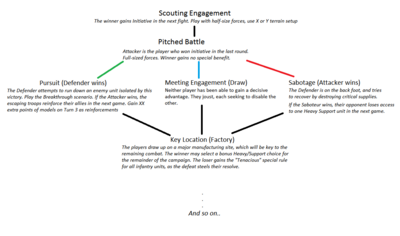Ladder Campaign
Also known as a "tree" or "pyramid" campaign, for the shape it takes when you diagram it. This is one of the classic ways of organizing a wargaming campaign, and one of the better ones for a two-player setup - there's no need for a GM once you start playing. Also works well as part of an Escalation League. Compare to Map and Random campaign systems.
How It Works[edit | edit source]

Basically, a Ladder is a series of linked, potential games. Players roll off or chose the roles of "Attacker" and "Defender" before the first game. Once it's over, the players trigger the next scenario based on who won. These generally run through 3-5 games, with the degree of victory determined by who won the most games overall. Each scenario may give limited advantages to a player in the next; for example, a "Sabotage" game could remove access to a powerful unit type or air/artillery support, while a "Scouting engagement" might give the winner automatic initiative in the next game. These are usually set up so that a player who has been doing poorly can get a chance to recover and gain the advantage for the next scenario, creating a sort of tug-of-war. Generally the campaign diagram will split out to a choice of smaller games after major engagements, then converge back to one or two larger game options before splitting off again.
If you're an organizer, Ladder campaigns can be very hard to balance and keep engaging for multiple players. On the other hand, they're a simple way for a few friends without a GM to still have fun running a narrative game, and the time spent tracking results is much simpler than most. It's also the easiest system to use if players want to swap units in and out of their forces, since you're not exhaustively tracking each one's fate between games. Because of this, Ladders work best with a Company-level or larger game system, where players control multiple semi-independent squads and units working together. Skirmish-level games usually encourage players to spend more time and care on individual models, and the standard campaign systems for those games already add consequences to each game session.
Variants[edit | edit source]
- Each player has a limited number of special scenarios or command cards they can play to give one-time bonuses. Very hard to balance, so mostly used for fun in a club game or between long-term opponents looking to spice things up.
- For campaigns with more than 2 players, each player picks an alliance. Which opponent you face next is randomized. This can reduce the narrative impact of a campaign, but means you're not constantly facing the same person for weeks of gameplay. It also means the guy whose regular partner didn't show up can still dance on club night without having to start a new ladder.
- One side of the campaign is a fixed "OPFOR" (Opposing Force) run by a GM or another player. Each individual player runs theirguys through the full ladder campaign, alternating between playing the fixed OPFOR against the other players and playing their own matches. This is fairer than some of the other setups if you want to do a convention or multi-week tournament setup. And easier to set up as a tournament organizer. The BattleTech Chaos Campaign System uses this variant.